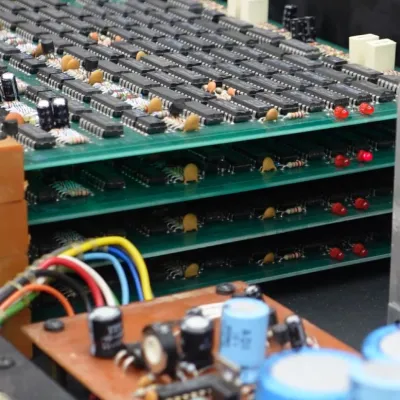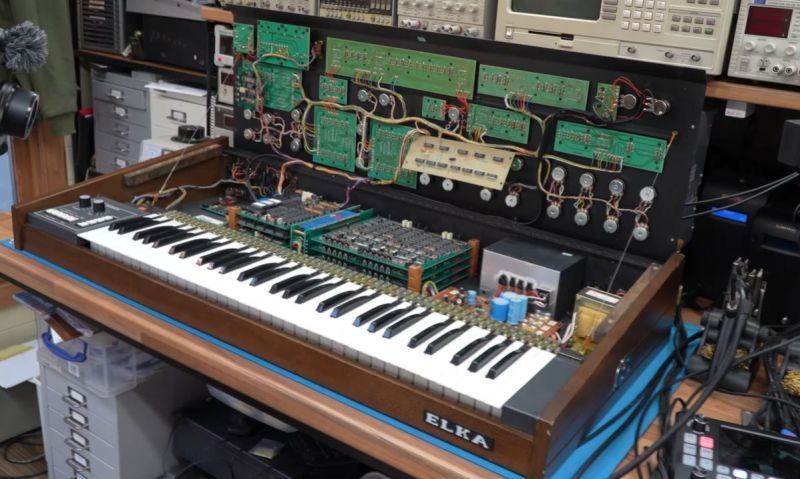
Somehow, an Elka Synthex analog synthesizer made it onto [Mend it Mark]’s repair bench recently. It had a couple of dud buttons, and some keys produced the wrong tone. Remember, this is an analog synthesizer from the 1980s, so we’re talking basic 74LS chips and kin. Fortunately, Elka helped him with the complete repair manual, including schematics.
As usual, [Mark] starts by diagnosing the faults, using the schematics to mark the parts of the circuitry to focus on. Then, the synth’s bonnet is popped open to reveal its absolutely gobsmackingly delightful inner workings, with neatly modular PCBs attached to a central backplane. The entire unit is controlled by a 6502 MPU, with basic counter ICs handling tone generation, controlled by top panel settings.
The Elka Synthex is a polyphonic analog synthesizer produced from 1981 to 1985 and used by famous artists, including Jean-Michel Jarre. Due to its modular nature, [Mark] was quickly able to hunt down the few defective 74LS chips and replace them before testing the instrument by playing some synth tunes from Jean-Michel Jarre’s Oxygène album, as is proper with a 1980s synthesizer.
Looking for something simpler? Or, perhaps, you want something not quite that simple.















Ah. you saw that video on youtube too.
Now im curious how big the venn diagram overlap is between people reading hackaday and people getting this video as a suggestion in their feed.
Large overlap, me think.
All slaves to the youtube algorithm. Especially those people who are a bit bored or click around to fill some time.
⃝ ⃝
“Remember, this is a completely analog synthesizer from the 1980s, so we’re talking basic 74LS chips and kin.” Actually, 74-anything is TTL digital. But yes, same era. Peerhaps 4-quadrant analog multipliers, VCAs, VCO, etc. in IC form.
In the synth world, the difference between analog and digital is whether or not there’s a CPU/microcontroller involved. The distinction makes sense from the musical perspective, but less so from an engineering perspective.
Just wrong. Nobody thinks e.g. Prophet is a digital synth just because it’s under computer control.
Even something like Korg DW-8000 is considered hybrid.
People make the distinction based on whether the signal path, not the control path, contains DACs.
What about oscillator? Can it be digital?
I guess “analog synth” means it’s filters are analog. Oscillator being digital doesn’t make that much a difference and envelopes or other filter exciters can be digital too?
Analog oscillators are never the same, so you get “built-in effects” when mixing them.
Two digital oscillators will track perfectly every time if run from the same clock source.
Dude: you can easily emulate analog oscillators in a level that nobody notices. Add some very suddle randomness to the frequency and use rolling oscillators – no one can pick them up after the whole signal path.
If not, are all digital osciallator “analog synths” then digital synths?
Filters + effects are the ones who make the “sound”.
“Analog” in the synth world usually only refers to the audio chain; a lot of “analog” synths, particularly the polyphonic ones like the Synthex, extensively use digital systems for controls, and that’s where the 6502 and TTL logic comes in.
From what I recall from the video the oscillator waveforms are actually digitally generated, using (somewhat disappointingly) a discrete 8-bit resistor dac, so not very accurate but I suppose that adds to the character ?
So basically a DCO + analog filter architecture
Square waves my friend
Great video, it was fun to watch the diagnostic steps!
Haven’t watched yet but in that cover shot I see banks of plugin circuit boards and their mother board solder joints that often fail. Gold, solder or bare copper as an edge connector times many. A time when lots of area was needed and was broken up into boards and a wiring harness or printed mess of trouble and plug-in ease for now.
Very nice to see the inner secrets of a Synthex, recently I have seen one
live in… “person”, but not the insides